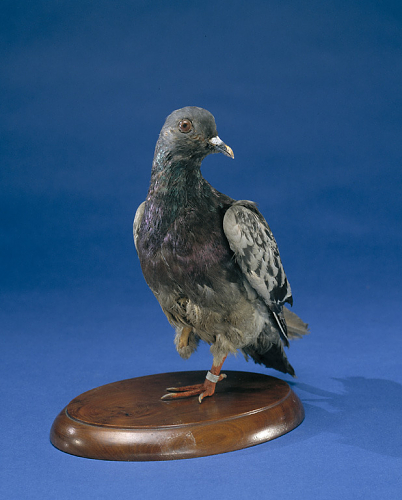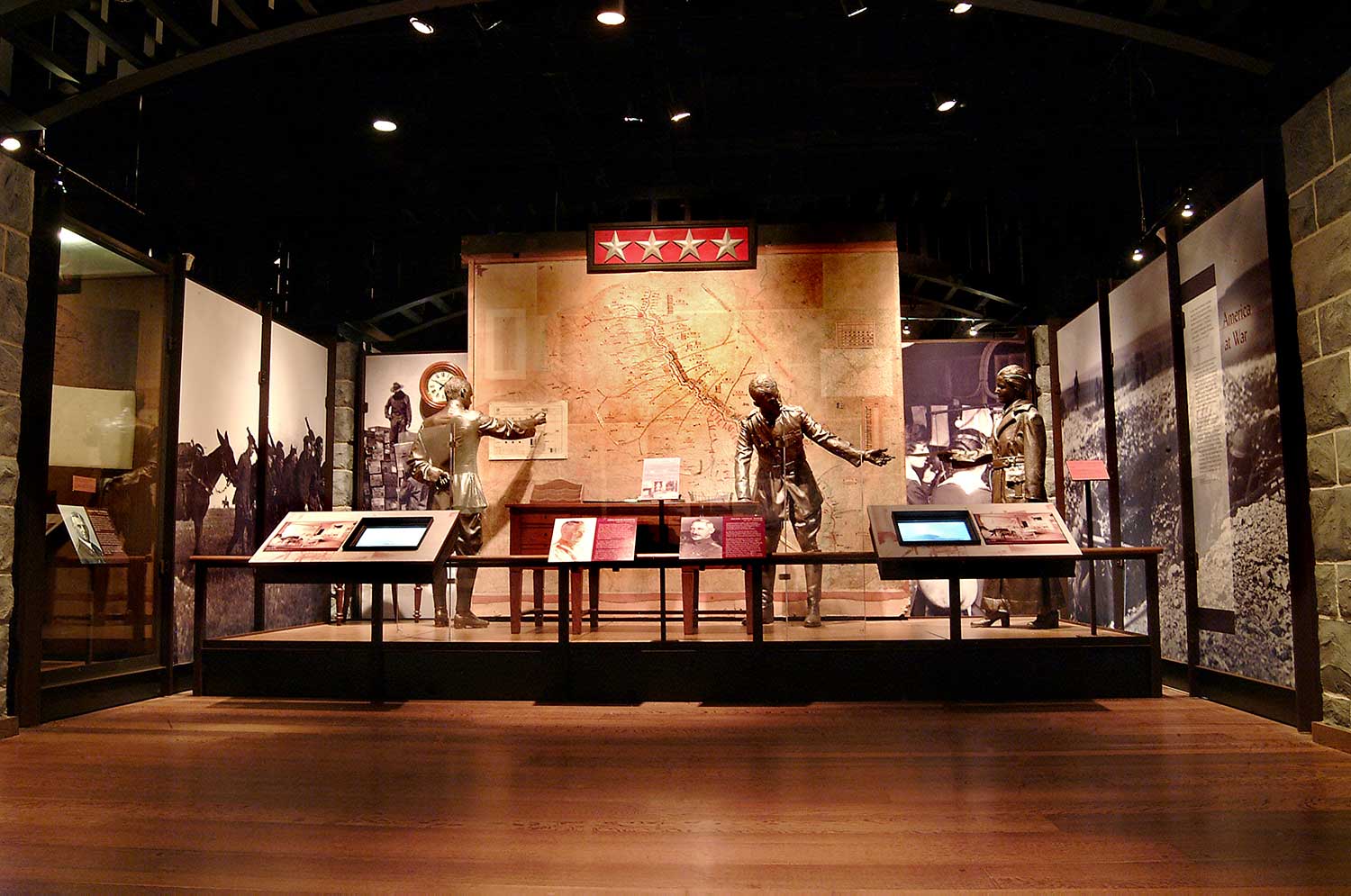WWI: Collecting and Interpreting the War

Because World War I was sure to go down in history, the curator of the History Division, Theodore T. Belote, began collecting artifacts documenting the war even before it was over. As the war wound down and soldiers started returning home, Belote and his superiors at the US National Museum worked with the War Department and contacts in the Army and the Navy to document the war. Almost immediately, these objects went on display to the public, interpreting wartime technological innovations and memorializing the country’s participation. These efforts can still be seen around the Smithsonian today, from the Carrier Pigeon Cher Ami in the National Museum of American History to planes on display in the National Air and Space Museum.
WWI Collecting
By October 1918, William deC. Ravenel, the Administrative Assistant to the Secretary, wrote “we expect to commence installing the material which we have on hand very shortly and open it to the public.”3 But the rapid influx of material presented one very big question: where to put it all? Despite the specimens and displays that filled the National Museum Building before the war, the Bureau of War Risk Insurance’s presence in the building meant it could be easily rearranged for new materials when they vacated the building. In October 1918, all of the space they occupied went to the incoming war artifacts.4 But the War Collection soon needed more space. William Henry Holmes, Curator of the Department of Anthropology, felt there was no space for the War Collection in the Arts & Industries Building,5 but by 1925 the guidebook shows halls there devoted to the War Collection.6 Comparing floorplans from 1917 and 1920 shows just how much had changed within the museum.
 Rapidly expanding War Collections also necessitated expertise in military knowledge, and curators asked the War Department for experts who could aid in processing the rapidly accumulating collections.7 Colonel C.W. Weeks coordinated the assignment of officers to help write labels for the War Collection exhibit.8 With exhibitions of war relics happening throughout the country, Ravenel and Belote made sure as many of these artifacts as possible entered the Smithsonian’s collections. Letters went out requesting artifacts from Italy, photographs from Britain, and typical equipment from American soldiers; all to document the war as completely as possible and create the definitive war collection in America.9 The Smithsonian made the most of its government contacts with officers at home and still abroad to bring home artifacts for the museum.10 The most exciting of these contacts was General John J. Pershing himself, who agreed to collect for the Smithsonian while he was still in Europe.11
Rapidly expanding War Collections also necessitated expertise in military knowledge, and curators asked the War Department for experts who could aid in processing the rapidly accumulating collections.7 Colonel C.W. Weeks coordinated the assignment of officers to help write labels for the War Collection exhibit.8 With exhibitions of war relics happening throughout the country, Ravenel and Belote made sure as many of these artifacts as possible entered the Smithsonian’s collections. Letters went out requesting artifacts from Italy, photographs from Britain, and typical equipment from American soldiers; all to document the war as completely as possible and create the definitive war collection in America.9 The Smithsonian made the most of its government contacts with officers at home and still abroad to bring home artifacts for the museum.10 The most exciting of these contacts was General John J. Pershing himself, who agreed to collect for the Smithsonian while he was still in Europe.11
 Perhaps the most prominent artifact came from Pershing. The map he used to track and plan the movements of the American Expeditionary Forces came to the Smithsonian where it was prominently displayed for many years.12 But Belote did not just rely on luck and friends to ensure the National Museum captured the history of the war. He wrote a seven-page memo outlining a suggested plan for war collecting. He divided collecting efforts into several different priorities: insignia, equipment and uniforms, planes and technology, among others.13
Perhaps the most prominent artifact came from Pershing. The map he used to track and plan the movements of the American Expeditionary Forces came to the Smithsonian where it was prominently displayed for many years.12 But Belote did not just rely on luck and friends to ensure the National Museum captured the history of the war. He wrote a seven-page memo outlining a suggested plan for war collecting. He divided collecting efforts into several different priorities: insignia, equipment and uniforms, planes and technology, among others.13
The Ordinance Department worked closely with the Smithsonian to display the latest in war technology. While shells were requested by the Smithsonian, they only wanted unloaded shells. Imagine their surprise when a shipment of fully loaded shells arrived at the museum! Not wanting to endanger themselves or the rest of the collection, the loaded shells were returned to the Ordinance Department, but not before a confused set of notes flew between museum officials.14
Other objects collected, as Belote instructed his colleagues not to “let any opportunity to acquire war relics pass,” included Air Service equipment, French caissons and limbers (artillery carts), war trophies, American Red Cross medals, a 6 ton Renault tank, and ship models from the Navy.15
Building a War Museum
Momentum gathered in the early months after the war to the point where the US House of Representatives considered HR 16006 to provide for the establishment of a war museum.17 The bill was never passed and the lack of congressional approval for the new museum doomed the attempt to failure. However, the dream of a war museum didn’t completely die. By 1921, the effort to create a museum dedicated to memorializing the Great War combined with the effort to create the George Washington Memorial Building. The vision of Susan Whitney Dimock and the George Washington Memorial Association she founded, the building was to be mixed use, with meeting rooms, office space, and a military museum and library. The building was to be placed under the control of the Smithsonian Institution. While this building got as far as laying a cornerstone and foundation, the Great Depression and high inflation rates meant it didn’t go any further.18
Conclusion
Theodore T. Belote was not alone in his vision of a war collection that would stand the test of time. Administrators and fellow curators like William H. Holmes, as well as soldiers and sailors from the War Department, helped Belote create exhibitions which allowed the American public to make sense of the war and America’s role in it. Whether displaying new technologies that changed how the war was fought or the uniforms and equipment of a soldier, the collections the Smithsonian acquired and the objects the Smithsonian displayed played a critical role in the American people’s understanding of the war.
FURTHER EXPLORATION
- History of the National Museum of Natural History
- Imperial War Museum
RELATED COLLECTIONS
- United States National Museum Permanent Administrative Files, 1877-1975, RU 000192
- Pershing Map, 1918, National Museum of American History, Kenneth E. Behring Center
FOOTNOTES
1 Smithsonian Institution Archives, Record Unit 192, United States National Museum, Permanent Administrative Files, Box 194, Folder 2 Return to text
2 Smithsonian Institution Archives, Record Unit 192, United States National Museum, Permanent Administrative Files, Box 194, Folder 2, letter Sept. 10, 1918 Return to text
3 Smithsonian Institution Archives, Record Unit 192, United States National Museum, Permanent Administrative Files, Box 194, Folder 2, letter Oct. 22, 1918 Return to text
4 Smithsonian Institution Archives, Record Unit 192, United States National Museum, Permanent Administrative Files, Box 194, Folder 2, letter Oct. 19, 1918 Return to text
5 Smithsonian Institution Archives, Record Unit 192, United States National Museum, Permanent Administrative Files, Box 194, Folder 2, letter WHHolmes to Ravenel Return to text
61925 guidebook to the A&I Building, Institutional History Research files Return to text
7 Smithsonian Institution Archives, Record Unit 192, United States National Museum, Permanent Administrative Files, Box 194, Folder 2, letter to Hittinger Return to text
8 Smithsonian Institution Archives, Record Unit 192, United States National Museum, Permanent Administrative Files, Box 194, Folder 3, letters between Weeks and Ravenel Return to text
9 Smithsonian Institution Archives, Record Unit 192, United States National Museum, Permanent Administrative Files, Box 194, Folder 3 Return to text
10 Smithsonian Institution Archives, Record Unit 192, United States National Museum, Permanent Administrative Files, Box 194, Folder 4, R.W. Wood letters Return to text
11 Smithsonian Institution Archives, Record Unit 192, United States National Museum, Permanent Administrative Files, Box 194, Folder 3, Letter from C. W. Weeks, Letter from Secretary of War Return to text
12 National Museum of American History, Kenneth E. Behring Center, Armed Forces History, ID Number AF*35016, catalog number 35016, http://collections.si.edu/search/tag/tagDoc.htm?recordID=nmah_434551&hlterm=pershing%2Bmap, and personal communication with B. Daniels. Return to text
13 Smithsonian Institution Archives, Record Unit 192, United States National Museum, Permanent Administrative Files, Box 194, Folder 2 Return to text
14 Smithsonian Institution Archives, Record Unit 192, United States National Museum, Permanent Administrative Files, Box 194, Folder 4, various letters Return to text
15 Smithsonian Institution Archives, Record Unit 192, United States National Museum, Permanent Administrative Files, Box 194, Folder 5, various letters, quote from a letter between Belote and Holmes Return to text
16 Smithsonian Institution Archives, Record Unit 192, United States National Museum, Permanent Administrative Files, Box 194, Folder 2, letter comparing museum conditions in England and France; Report on creation of the Imperial War Museum Return to text
17 Smithsonian Institution Archives, Record Unit 192, United States National Museum, Permanent Administrative Files, Box 194, Folder 5 Return to text
18 “George Washington Memorial Building” in Capital Losses: A Cultural History of Washington’s Destroyed Buildings. James M. Goode. (Washington, DC: Smithsonian Books, 2003) 332-333. Return to text
